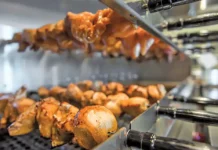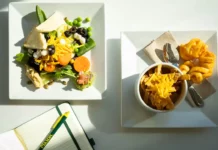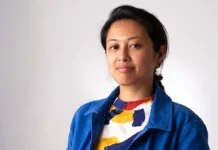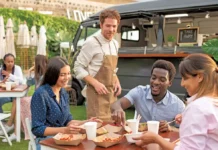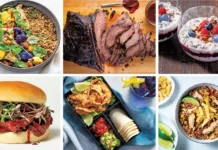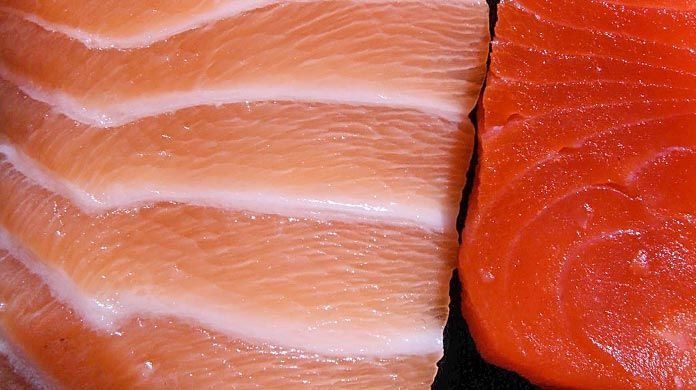
There haven’t always been so many choices for eating salmon. Long ago we had wild salmon along the Atlantic coast and along the Pacific coast, both teeming in freshwater rivers drifting to the saltwater seas they led to. The marketplace is much more difficult to navigate now.
Though you won’t find many wild salmon along the northeast coast of the United States today, the northwest coast is a different story. Five species of salmon – the king, the coho, the sockeye, the pink, and the chum – all call the Pacific Northwest home. Fisheries management on the state and national level has been strategic over many years in order to keep these species alive and well. Long story short, they are still around for us to enjoy.
So how has salmon become so popular all over the world and what kind of salmon are we actually eating most of the time?
Well, unlike its relative over in the Pacific, the Atlantic salmon’s fate did not turn out so well, as you might have guessed. A species that has been deemed “commercially extinct” for some years now, the only Atlantic salmon you can buy is a product of aquaculture, and to make a long story short, one of the most influential fish in the seafood industry because of its success.
Some say that the original biology of salmon pushed it into the hands of those who were eager to recreate it – the farmer of fish, the aquaculturist. All salmon, starting their life in orange, oily, nutrient-rich eggs, solved one of the first aquaculture equations on their own – how to feed themselves. Most other common food fish start as needy, microscopic specks, difficult to feed and nurture even after they are visible.
This isn’t to say that farming salmon happened overnight.
Instead, you could say it had just given those who were keen to rear it a head start in comparison to other fish they had to choose from because of the fish’s basic biological details. In the last few decades, we can look back and see the exponential growth of salmon’s aquaculture internationally, with huge leaps and bounds outlining its success. Selective breeding can be used for many things, but a main use for aquaculture and farming in general is this: it is the process of choosing fish who grow faster on less food and are more efficiently converting their feed to harvestable protein. This is done with other animals all over the world, like pigs, chickens, and cattle.
So the farmed Atlantic salmon is successful; a species that would have otherwise disappeared in our culture as food is now produced all over the world. All thumbs up? Well, not exactly.
The positives? The whole point is to feed the masses, and that is what this fish has done very well. A rich, flavorful, fatty fish, loaded with protein and heart-healthy omega-3’s, is now affordable to many internationally. The negatives? Those beautiful, fat-marbled fillets contain these heart-healthy compounds, but do they also include as much mercury and polychlorinated biphenyls as the Internet says they do? Do the risks outweigh the rewards? When you read these reports, why does it seem we are we lumping all salmon into the same category? Not all salmon are created equal; there are arguably too many details to consider to make any kind of blanket statement.
There are a few questions you can ask, however. Even our food needs food, right? So what do you feed the salmon? Are the salmon raised in a closed, inland system that re-circulates its water supply? Or are they left to grow inside a net close to the shore of an ocean or river, carefully policed in case of an escapee that threatens to endanger local wild populations? What about chemicals? Additives? Antibiotics? What kind of biosecurity measures do these coastlines have, and to what extent does legislation dictate the salmon’s feed, their processing, their transport?
After all, “salmon” comes from farms all over the world – even now here in the United States. Speaking of which, we have even created our own kind of salmon. Wild, farmed, and now we have genetically modified – or at least that’s the plan.
When scientists developed the AquAdvantage Salmon more than fifteen years ago, they knew that a king salmon is the largest and that the Atlantic salmon was already the most perfected by breeding in aquaculture. A tertiary and final piece of the puzzle was incorporating the ocean pout, Zoarces americanus. This eel-like bottom dweller has inspired more than one scientific stretch in the food industry. Instead of its blood freezing in ultra-low temperatures deep in the Atlantic, evolution has decided otherwise. Within its blood there is a “promoter” for a gene that creates an antifreeze protein. This protein is easily recreated by scientists within yeast and used for a number of things in the food world, most notably in low fat ice cream and now, in the aquaculture of salmon. Boring details aside, this antifreeze gene makes our “salmon” grow significantly faster than it did before.
Upon joining these three pieces of the puzzle, AquaBounty Technologies has come up with a way to use these three animals all together, creating a farming phenomenon. This is not selective breeding; this is creating a fish that does not naturally occur in nature and never would. Through the fog of many objections, AquaBounty says that all salmon it would raise would not only be farmed in a closed, inland system (practically eliminating the risk of ever being able to come in contact with other wild salmon), they will also all be sterile females. Some lawmakers, even question whether or not it even has the right to be called “salmon,” myself included.
Only a few months ago, it was not required to even label the product as genetically modified because it is said to have “the same nutritional value” as regular Atlantic salmon. Extraordinary! A new organism meant for food is created in a lab – the first of its kind to this magnitude – and we’re allowed to call it what it resembles nutritionally? In the future when the product becomes available – whenever that may be – it will in fact require some kind of differentiation in labeling. Though it is unsure what that may be as of right now, it shows the serious and utter importance of having to fight for the correct information that we assume will be right under our nose.
On the other end of the spectrum of aquaculture, we introduce those who are arguably more concerned with quality, not quantity. They are intrigued by not only raising a healthy fish; they are interested in creating a sustainable one.
Let’s revisit this question – what do we feed salmon? How can we supply them this energy that they crave? Think of the genetic makeup (by nature’s definition) of salmon. Bright orange flesh (naturally colored by krill and other parts of their diet) is marbled with enough energy-storing fat to swim up a river. Pause, reflect. That is an enormous amount of energy. These animals are carnivores and rightly so. They need fuel.
Forage fish, or fish at the bottom of the food chain, are used in the production of fish meal and fish oil, as well as supplements and other products for people around the world. For salmon and their farmers, fishmeal and fish oil is necessary in the rearing of this food source, but how efficient is this conversion? Over many years of selective breeding, the ratio of “pounds of fish food” to “pounds of salmon” has gotten increasingly better, but is still an unimpressive average of about 5:1. That means that it takes five pounds of fish taken out of the ocean to make one pound of salmon to serve on a plate. I see room for improvement, and so does the science of aquaculture.
Technology and research are pushing to change much more than conversion rations and the ability to learn from selective breeding data. They are succeeding – a positive movement in the ever-changing world of food and farming. Some companies have even gone further to develop a way to have a net positive – one pound of forage fish can be used to raise more than one pound of salmon. They come out with more fish than they started with.
This concept of a salmon’s food is another light in the room for aquaculture and farming in general, that this all has to come from somewhere. Education is the first step, and it’s not enough to read brief articles with unexplained facts in each and move on. There is much to learn, and much to improve upon – not only with salmon, but with farming and fisheries all over the world – not to mention increasingly more and more in aquaculture.
Aquaculture has solved many problems in the world of food, but that’s not to say it hasn’t created others in its path. The vague and confusing cloud surrounding the salmon of the world does little to help educate chefs and consumers in a positive way, or to promote those who are truly raising a food source with integrity and transparency. We as chefs and consumers must fight for information, to better this industry. We have to want the facts, the proper labeling requirements by aquaculturists, fishermen, and the lawmakers that guide them. We are all an important part of pushing this industry to not only stay safe and healthy, but also to become ameliorated.
And this all starts from knowing your right from your left – your Pacific, from your Atlantic.
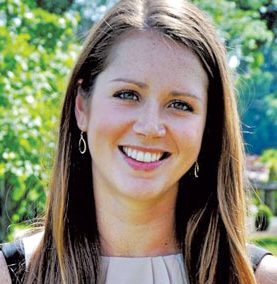 With four generations of commercial fishing influence and many summers working at her family’s restaurant, Sonja Panacek grew up in southern New Jersey and now resides in Brooklyn, NY. She is the marketing coordinator at Pierless Fish Corp., a wholesale seafood purveyor for the NYC area. An avid runner and self-proclaimed foodie, Sonja has a BS in Management from the University of Tennessee, and studied French for a year in Lyon, France.
With four generations of commercial fishing influence and many summers working at her family’s restaurant, Sonja Panacek grew up in southern New Jersey and now resides in Brooklyn, NY. She is the marketing coordinator at Pierless Fish Corp., a wholesale seafood purveyor for the NYC area. An avid runner and self-proclaimed foodie, Sonja has a BS in Management from the University of Tennessee, and studied French for a year in Lyon, France.


















